Contents
Finding No. 1 - Updated 24 December 2019
See the article by Colin Churcher The Sussex Street Station, Ottawa - Branchline, December 2004. Ottawa's first railway terminus was opened
by the Ottawa and Prescott Railway on 24 December 1854. The
Rideau River was not crossed by trains until early in January 1855.
It has been suggested that at a temporary station in New
Edinburgh was used until May 1855 but there is no evidence to suggest
this although a temporary stopping place was used in the
spring of 1855 because of high water in the Rideau River and potential
problems with the bridge over the river. The original station was
destroyed by fire on 7 May 1860 and was rebuilt. There are two
early pictures of the station CA-18221 (City of Ottawa) and C-957
(Public Archives).
Public Archives picture C-957 The St. Lawrence & Ottawa Passenger Station appears on the 1878 Insurance map, (NMC 0010731 7/49). It was a free-standing 1.5 storey building, 24 x 60 feet with 4-foot overhanging eaves on all sides. The platform ran 375 feet west from Dalhousie. The freight shed continued 290 feet to Sussex. A building the same size as the station at the east end of the freight shed, had a baggage room in its eastern third. Double track ran along McTaggart Street from Dalhousie to the Rideau River. Crossovers east of Dalhousie and at King Edward formed a 1000-foot passing track. The station was on the south side of a single track, though its platform was built for two tracks. Its east wall was 250 feet from the centre line of Dalhousie. Three additional yard tracks to the north and one south of the station also extended to Sussex. With the take over of the St. Lawrence and
Ottawa by the Canadian Pacific Railway passenger service to Prescott
was transferred to the Union station at Broad Street, effective 22
August 1885. From then on, Sussex street was used only for
freight and there was even talk of closing it in
the late 1880's when the Rideau River bridge became unsafe and the
railway was reluctant to spend the money to rebuild it. For much of the nineteenth century the station seems to have been referred to as the St. Lawrence and Ottawa or Lower Town station. Because it could not reach agreement with the Canada Atlantic Railway over the use of Central Depot, the Ottawa and New York Railway used this station when it inaugurated service to Ottawa in 1898.  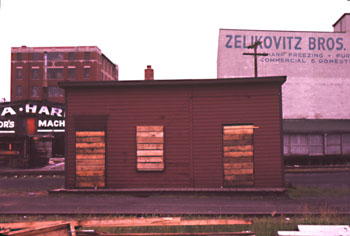 |
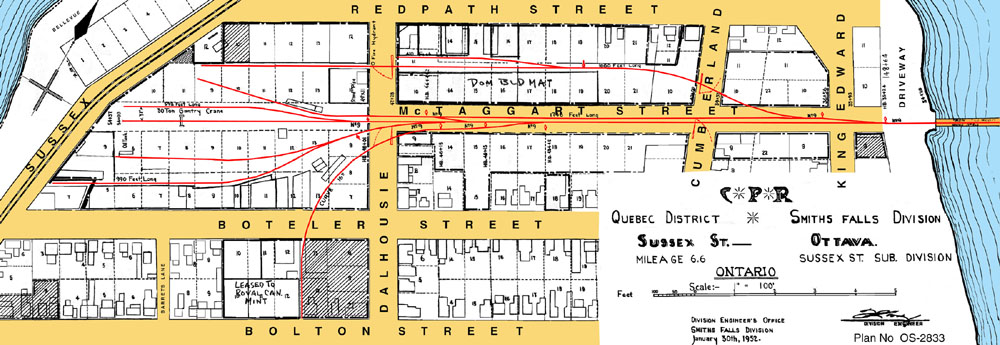
The St. Lawrence and Ottawa Railway opened a
branch from Chaudiere Junction to Chaudiere on 13 December 1871.
A station was constructed running east-west opposite the north end of
Preston Street, a little north of Richmond Road. This seems to
have been for freight only as passenger service on this line did not
start until 22 August 1885 by which time the Canadian Pacific had taken
over and passenger trains used the "Union" station.(see 1.2.2).
This station was turned into a paint shop by October 1882 (Ottawa
Free Press 30 October 1882).
|
|
The Canada Central Railway opened from
Chaudiere to Carleton Place on 15 September 1870. A station had
been completed and was being painted on 28 June 1870, well in advance
of the opening (The Times, Ottawa of same date). This line was
built to the Provincial or broad gauge of 5' 6" and was not converted
to standard gauge until March or April 1880.
The 1878 Insurance map shows the original
Canada Central Railway Passenger Depot on Lebreton Flats, (NMC 0010731
4/49). It was an L-shaped building, 60 x 30 feet, 350 feet west of
Broad Street, and 100 feet north of the line of Ottawa Street. Its long
side faced the east side of the track with a 300-foot platform. The
single track also led to a 3-track yard, running There were three small outbuildings: one at each end of the platform, probably for signalman and switchtenders, and one near the depot, possibly toilets. A long freight shed ran just south of and parallel to the line of Ottawa Street, west of Broad Street. This became the site of the 1881 Passenger Station. No photos have been found. |
|
The Quebec Government's Quebec, Montreal,
Ottawa and Occidental Railway reached Broad Street via the Prince of
Wales Bridge on 3 December 1880. A new Canada Central Union
Station was opened in May 1881 to handle Canada Central and Quebec,
Montreal, Ottawa and Occidental trains. This is a picture of this
station.
This picture of the old Ottawa Broad
Street station was most likely taken in 1892. The Ottawa Citizen
of 22 December 1892 reads:
A new safety switch has just been patented by J.P. Kelly, section foreman on the Canadian Pacific railway and Jos. Leslie, the new roadmaster on the Parry Sound railway both of Ottawa. The inventor is Mr. J.P. Kelly. It is claimed for the new invention that it will positively prevent derailment from an open switch. The patent is adaptable to both single and double switches. It stated trials have been made which prove the anti derailing qualities of the switch. In addition to its sureness it is claimed to be light in weight and easily worked. It is said the C.P.R. will make a test of the new invention with a view to its adoption. The foreground stub switch would appear to be
the switch referred to. It is quite complex with throw bars and
two spacer bars. The long "guard rail" on both sides would crowd the
flange of the wheel on one side forcing the other flange to ride up
over the spacer bar and climb over the running rail. This would
happen for moves approaching the camera on both tracks. The
modern equivalent would be a spring switch. The station is shown as an L-shape, slightly angled to Broad Street at the west end of Ottawa Street, and with a width across the platforms of about 80 feet. The architecture of the station and freight sheds is the typical Victorian style with roof-end cross-bracing and carved rooftop finials. In the background is the silhouette of the Victoria Tower and the centre block water towers behind the telegraph pole on the right, and part of the west block Mackenzie tower at the extreme right edge. In the centre are the buildings on the west side of Broad Street between Ottawa and Queen Streets. The plans show that the gable end facing the centre platform was on a transverse wing whigh continued the L-shape towards Broad Street. It may have contained an imposing approach to the main platform. The right side platform was to allow carts to get close to the train. The left side platform was triangular with an unsheltered side. The two station tracks converged to a single track throat to the Canada Central, just west of the aqueduct, whose parapets are visible. The track diverging to the far right is likely to be the Prescott connection. The two-arm starter signal is interesting. Its function is not clear but it would appear to control the entrance to or exit from the two adjacent station platforms. There is a poor quality photo in the Merrilees Collection in the National Archives (PA-207507) taken on 6 June 1891 of Sir John A. MacDonald's funeral train. The locomotive is CPR no 283 and the notes on the photo say it was taken at Queen Street. There is a building behind and what may be a platform canopy. Clearly this was located at this station. The Canada Central Union
station was destroyed in a disastrous fire on 14 November 1895. 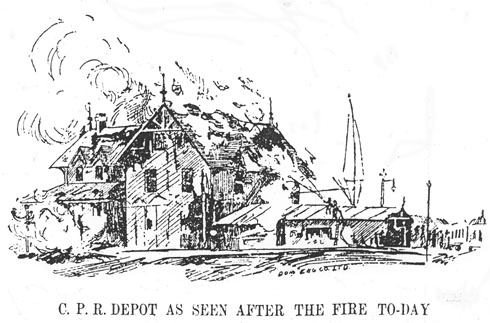 |
1.3 Canadian Pacific - Broad Street (known as Union Station) stations
Click here to see this article in Branchline on the CPR Broad Street Station
Canadian Pacific - First Broad Street station (known as Union Station)
Canadian Pacific built two stations at Broad
Street. The first, opened on 28 January 1896, was a replacement
for or a major rebuild of the Canada Central Union station which burned
on 14 November 1895 and little is known about it as it had a relatively
short life. It was remarkably similar to the building it replaced
and was erected in great haste. It was burnt in the great fire
of Ottawa Hull of 26 April 1900.
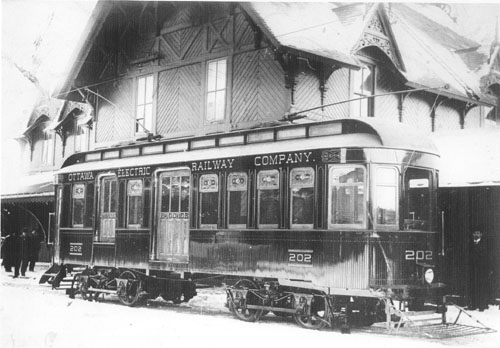

This picture, PA-135438, from the National Archives, shows the first Canadian Pacific Union Station a day or so after the fire of 26 April 1900. It is taken from Wellington Street, just west of Broad Street, looking towards the Chaudiere. In the foreground are the tracks of the Canada Atlantic Railway, two may have been cleared to restore access to the Chaudiere, where Booth's mill was not destroyed. Trucks of destroyed freight cars are on two of the Canada Atlantic tracks.
Behind is the debris from a coal stage of the St. Lawrence and Ottawa, which had a high level unloading track. Behind it is a platform of the St. Lawrence and Ottawa, which appears undamaged. A track of destroyed St. Lawrence and Ottawa freight car trucks is behind.
Beyond that are two damaged stone walls which were the partitions in a row of three one-storey storehouses owned by E.B. Eddy, just west of Broad Street. The St. Lawrence and Ottawa and E.B. Eddy site shown here was to be redeveloped over the next few months as the new CPR second Broad Street Union Station.
Behind the lumber yard is part of a row of fence posts, a line of trees, and the aqueduct leading to the water works. This is below grade so not visible. Behind the aqueduct is a triangular piece of open ground, widening towards the west at Broad Street.
Behind this are the remains of the station platforms, visible as a horizontal line, with ruins of the station building at the right. A tent has been erected as a temporary station, probably on the triangular platform at the north side of the station. The tent was the second temporary station after the fire. On 27 April 1900 "a small office in connection with the roundhouse on the Richmond road was improved as a station" although by 3 May a tent was in use and by 5 May trains were running from the former station site with the tent shown above. There is a crowd on the platform, where a train with two coaches, a baggage-mail-express car and at least four head-end baggage cars is loading.
A second train of baggage-mail-express and two coaches is waiting further up the track that ran along Broad Street. The silhouette of Booth's surviving Chaudiere sawmill is seen behind this train. The debris of the station is directly in front of the baggage-mail-express car. There may be a burned-out locomotive in front of the clerestory baggage car of the first train.
Canadian Pacific - Second Broad Street Station (known as Union Station)
It was built between late July 1900 and January 1901 at a cost of $25,000 by the Canadian Pacific Railway. Broad Street station, with its six tracks, was known, for many years as, "Union Station". At the turn of the century the CPR had great plans to connect Broad Street Station to the Grand Trunk Central Station on Confederation Square by a railway tunnel under Wellington Street. This plan was deferred due to the costs arising from the fire.Broad Street was designed by a celebrated Montreal architect, Edward Maxwell the elder of the two brothers who constituted the firm of E & WS Maxwell. This firm was a major architectural firm in Montreal in the first part of this century and did many many buildings across Canada. Their work was commemorated in an travelling exhibition in 1991 which was presented in Montreal, Winnipeg, St John and Quebec City. The catalogue for the exhibition is a good record of their work and a very useful research tool. Their work covers many fields and a complete record would be many times the size of the catalogue, which is already 190 - 11" x 8.5" pages.
The catalogue contains a chapter devoted to Hotels and Stations, which covers CPR's Vancouver Station, (1897-1913), CPR's Sicamous Junction Station and Hotel, 1898-1964, CPR's Arnprior Station, 1898- demolished (Almonte, Pembroke & Renfrew were built to similar designs). CPR's Winnipeg Station and Royal Alexandra Hotel, 1904-1971, CPR's Palliser Hotel (Calgary)1911- ), CPR's Chateau Frontenac (central tower & additional wings) 1920- ).
In the discussion of the Vancouver Station, the following comment is made" Edward used these castle-like elements on most of his other CPR designs of the time including the similarly treated Broad Street Station in Ottawa (about 1900, ...)". unfortunately no pictures or plans were included.
Passenger service ceased when the CPR began to use the GTR Union Station in January 1920. The National Archives online catalogue has, from the Clifford M. Johnston collection, Broad Street Station, the C.P.R. Depot, Deserted, 1930, C-034440 so it would seem it was still standing then. The 1922 Fire insurance map shows it as vacant.
A picture in the Public Archives (PA 28212) shows a view of the Rideau Canal "looking west" (but actually due south) in 1902. It shows the railway swing bridge over the Rideau Canal, apparently made of wood, a short trestle extension at the west end of the bridge, and a large, almost barn-like building running along the rail line on the south side, west of the bridge. A steam locomotive is partly visible on the west side of the canal, facing the camera, and a passenger car is parked on the line in front of the building. This could well be the Stewarton station. Stewarton was named for a farmer, William Stewart, who in 1834 purchased the lot bounded by Gladstone, the Canal, Bronson, and Isabella Streets. His family later retained the site of the Victoria Museum for their house built in 1870, and in 1887-8 McLeod Stewart was Mayor of Ottawa. Mcleod Street is named for him. The Bank Street Yards were therefore entirely on Stewart's lands. (From Courtney C.J. Bond, City on the Ottawa,NCC, 1967, Page 69.)
1.5 Canada Atlantic - Richmond Road/Chaudiere Falls
The first Canada Atlantic Railway station in the Chaudiere or Lebreton area was opened on 1 January 1885 (Ottawa Citizen 3 Jan. 1885) and was located at Richmond Road at Broad Street.
"The new passenger station of the Canada Atlantic Railway at the Chaudiere was opened for the convenience of passengers on New Year's Day. It is a very neat and comfortable building and will be no doubt appreciated by passengers at the West End."
This was also known as "Chaudiere Falls" and passenger services
started from this point on 2 January 1884 (two trains in each direction
with connections to and from the Montreal trains at Elgin street.
The January 1885 fire insurance map shows this 1-storey building, on
Richmond Road at Preston Street,
at the west end of the 600-foot platform. Its
size appears to be about 32 x 24 feet. Its longer dimension is along
the street, so it was probably not
a pre-existing house. This size is consistent with a "Barrington"
style station. (Barrington was also built in 1884, as
"Johnson's"). The location at the outer end of the platform
makes sense, as the
site was too narrow to allow a building beside the platform.
The June 1885 timetables show the trains from Ottawa to Montreal, originating at Richmond Road and running to the main Elgin Street station and the Ottawa Evening Journal of 9 August 1887 notes
"the Canada Atlantic Railway Company are now running all
their regular trains to the station at the Chaudiere instead of as
formerly only stopping at the Elgin street depot."
However, by 1888 a connection was made with an engine and a
passenger car at Elgin Street to bring passengers to and from Richmond
Road. Trains ceased using the Richmond Road station in June 1888
as this notice in the 16 June 1888 edition of the Ottawa Citizen
indicates (a similar note appeared in the Ottawa Journal n the same
date):
"Owing to construction work on the Chaudiere branch of the Canada Atlantic Railway passenger trains heretofore leaving the Richmond Road station are discontinued until further notice."
This notice appeared in subsequent editions until June 19th when
the CAR timetable advertisement was modified by deleting reference to
the Richmond Road service
The Richmond Road/Chaudiere Falls station was intended as a temporary structure until the Chaudiere Extension could be completed as is indicated in the Ottawa Evening Journal of 3 October 1887:
"It is also the intention of the company to do away with
the small passenger station on Broad street, and use the new station
house on Bridge street as a central passenger and freight depot for
the Chaudiere and Hull."
It can be assumed, therefore, that the Richmond Road station ceased to be used as a passenger station about 16 June 1888 and was replaced by the Chaudiere station (see 1.6 below).
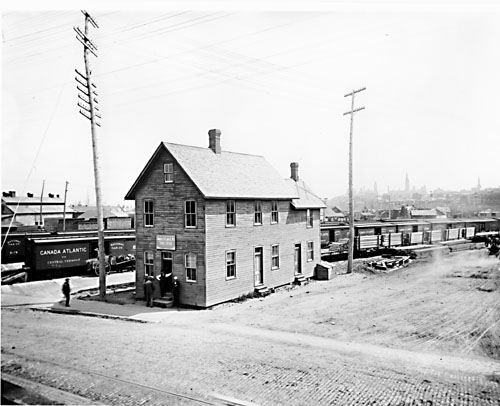
National Archives PA-027295
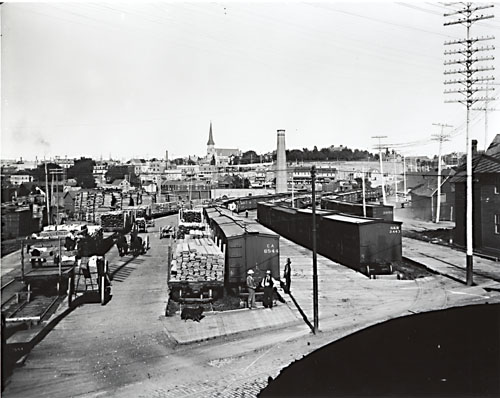
National Archives PA-008952
The above two William Topley photographs, presumably taken at the same time in 1893, show the Bridge Street station (it is to the far right in PA-008952).
The station was destroyed in the great fire
of Ottawa-Hull on 26 April 1900 and was replaced by a smaller
structure which survived into the 1960's
The following exchange from the minutes of the Privy Council Railway Committee meeting of 21 May 1901.(National Archives RG 46 vol 1516 file 9) indicates that the Canada Atlantic had a station in the Chaudiere at that time:
"Is the CAR used for other purposes than to
haul lumber to the yard?"
"Yes - they sometimes bring passengers in,
they have a small station here."
This is the main line of the Canada Atlantic
to Britannia Station. It was in existence before 1897.
The reference to Britannia is Britannia Terrace and not Britannia village on the Ottawa River/Lake Deschenes to the west.

Updated 13 February 2025